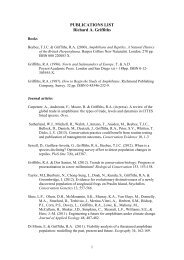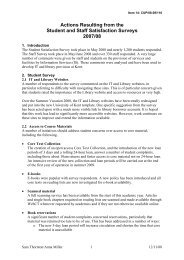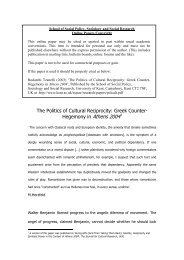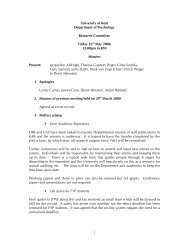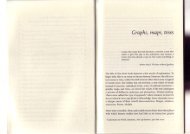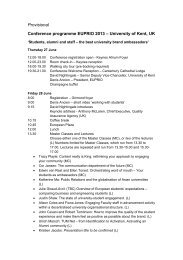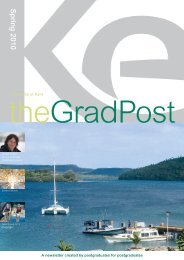Download - University of Kent
Download - University of Kent
Download - University of Kent
Create successful ePaper yourself
Turn your PDF publications into a flip-book with our unique Google optimized e-Paper software.
STAFF PROFILE<br />
<strong>University</strong> <strong>of</strong> <strong>Kent</strong> / ARTS STUDIO<br />
CLIO BARNARD<br />
Clio Barnard’s work has screened in galleries including Tate Modern, London<br />
and MOMA, New York. Her critically acclaimed debut feature film, The Arbor,<br />
won awards at festivals around the world; she was also nominated for the<br />
BAFTA Outstanding Debut Award in 2011. Here, she tells us why she<br />
became a filmmaker and why she enjoys teaching at <strong>Kent</strong>.<br />
When did you first get<br />
interested in film?<br />
The film that really got me thinking<br />
was Andrei Tarkovsky’s Andrei<br />
Rublev. I remember thinking that<br />
here was the ultimate art form,<br />
because you could work with<br />
sound, moving image and words.<br />
I saw the film at an impressionable<br />
age and was really blown away<br />
by it.<br />
Your first degree was in fine art;<br />
when did you focus on film?<br />
I was doing big charcoal drawings<br />
and to make a record <strong>of</strong> how they<br />
progressed and changed, I set up a<br />
Bolex 16mm hand-wound camera<br />
so that I could take single frames <strong>of</strong><br />
the drawings. This then turned into<br />
an animation. I got excited by the<br />
magic <strong>of</strong> film and started shooting<br />
live-action 16mm and Super 8<br />
footage. I forgot about the other<br />
things I was doing; I was really<br />
seduced by film.<br />
I then took a postgraduate course<br />
and immersed myself in making my<br />
own work. I made a piece <strong>of</strong> video<br />
art called Dirty Science, which was<br />
selected by Tilda Swinton for an ICA<br />
show. It was very early in my career<br />
and it felt great that somebody else<br />
had chosen my film and that lots <strong>of</strong><br />
people would now see it. I then got<br />
a job producing motion graphics<br />
and title sequences for MTV, Film 4<br />
and Channel 4, which supported<br />
me and allowed me to continue<br />
making my own work.<br />
When did you move into<br />
teaching?<br />
I was invited to work at the<br />
<strong>University</strong> for the Creative Arts<br />
(UCA) which has a very good<br />
experimental film and video<br />
course. I enjoyed teaching<br />
because I had to engage with<br />
ideas in a way that I hadn’t had to<br />
doing commercial work. I found<br />
teaching very intellectually<br />
stimulating. Seeing students’<br />
individual voices emerge is very<br />
exciting.<br />
Do you think teaching and<br />
filmmaking work well together?<br />
I think they have a very positive<br />
effect on each other. While I was<br />
teaching here and at UCA, I made<br />
a gallery installation called Road<br />
Race, which was inspired by many<br />
<strong>of</strong> the things I was engaging with in<br />
my teaching – such as ideas around<br />
documentary and the impossibility<br />
<strong>of</strong> recording the real.<br />
The film department here has a long<br />
history and an excellent reputation.<br />
Combining that with our recent<br />
move into a new building, which has<br />
excellent technical facilities, means<br />
that students get the best <strong>of</strong> both<br />
worlds. I feel very fortunate to be<br />
able to combine teaching and<br />
filmmaking and I think being taught<br />
by practising filmmakers has a<br />
hugely positive impact on the<br />
students.<br />
Your most recent film,<br />
The Arbor, has been very<br />
successful. What attracted<br />
you to this story?<br />
I started thinking about it in 2006;<br />
my interest grew out <strong>of</strong> my<br />
admiration for the work <strong>of</strong><br />
playwright, Andrea Dunbar and film<br />
director Alan Clarke, and from my<br />
ongoing fascination with the<br />
relationship between documentary<br />
and film. Andrea wrote her plays in<br />
the 1980s and died in 1990. Max<br />
Stafford-Clark, who directed her<br />
work, returned to Buttershaw, the<br />
place where Andrea was from and<br />
where the plays were set, a decade<br />
after her death to see how it had<br />
changed. The outcome was a piece<br />
<strong>of</strong> verbatim theatre, A State Affair.<br />
I was interested in the idea that a<br />
play or a film shapes an ending but<br />
that the place doesn’t end. So, I<br />
went back to Buttershaw to see how<br />
it had changed and also to reflect<br />
on the previous representations. In<br />
making The Arbor, I felt it was vital<br />
that people were reminded that<br />
what they were watching was a<br />
retelling <strong>of</strong> a true story. Actors<br />
lip-synch the words <strong>of</strong> the people I<br />
interviewed, which I think acts as a<br />
distancing device and draws your<br />
attention to the illusion.<br />
The film is award-winning and<br />
people’s responses to it have<br />
been very positive. How did<br />
that make you feel?<br />
When you make a film, you have no<br />
idea how people are going to<br />
respond to it. At the end <strong>of</strong> the<br />
filmmaking process, you are<br />
necessarily involved in the<br />
Recommendations<br />
minutiae, looking at whether it is<br />
bright enough or dark enough, or<br />
whether the sound should include<br />
a creak or not, so you begin to lose<br />
sight <strong>of</strong> the bigger picture. When<br />
the first reviews started coming in it<br />
was very rewarding. At the heart <strong>of</strong><br />
the film is a very tragic set <strong>of</strong><br />
circumstances and, in the making<br />
<strong>of</strong> it, I formed real bonds with the<br />
people involved. The fact that they<br />
also felt rewarded by its success<br />
meant a lot to me.<br />
A film to see before you come to <strong>Kent</strong><br />
It is different for everybody, and <strong>of</strong> course part <strong>of</strong> what<br />
inspires you is discovering something yourself, but having<br />
said that, two films that inspired me before I went into<br />
further education were Rashomon by Kurosawa and<br />
Performance by Donald Cammell and Nic Roeg<br />
9



